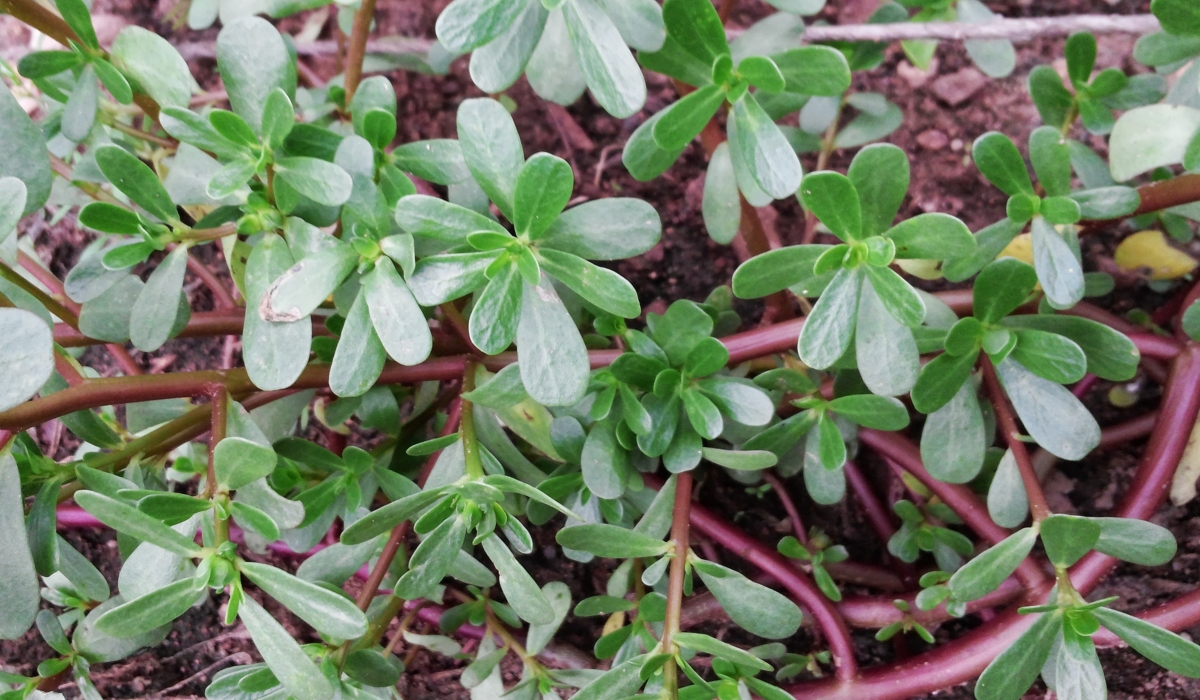
The scientific name for purslane is Portulaca oleracea, and it’s commonly known as pigweed, fatweed, pusley and little hogweed.
At 93% water content, purslane is a succulent plant with red stems and tiny green leaves. Some have compared its sour, slightly salty taste to watercress or spinach; it can be eaten in the same way as these better-known greens by adding it to salads and sandwiches.
Like many other wild plants, purslane is adaptable and you might see it growing up through cracks in the sidewalk or taking over a corner of the garden.
Purslane can thrive even in harsh environments where there isn’t much water, as well as in soil that’s overly salty, or lacking in minerals. (1, 2)
This hardy little “weed” has been used medicinally by practitioners of alternative and traditional healing methods, and is loaded with beneficial nutrients and compounds. (3, 4)
Benefits
It takes a lot of small purslane leaves to make a serving, but once you’ve got them in hand, you can expect a generous amount of important nutrients from a 3.5 ounce serving.
Purslane is rich in vitamins A and C, delivering more than a quarter of the DV for vitamin A and better than a third of the DV for vitamin C in a single serving; you’ll also get lesser amounts of vitamins B1, B2 and B3, as well as some phosphorus, copper and folate. (5)
Other minerals are present in respectable amounts, including calcium at 7% of the RDI, iron at 11% of RDI, iron at 11% of the DV, potassium at 14% of the DV, manganese at 15% of the DV and magnesium at 17% of the DV.
The calorie count for a serving of purslane is exceptionally low at 16, which is why it’s considered a nutrient-dense food choice.
Our bodies can’t make omega-3 fatty acids, so we need to get these vital substances from foods, and even though there’s not much fat in purslane, much of what it contains is in this form.
Two types of omega-3 fatty acids are present in purslane; while ALA, the first type, is found in many other leafy green vegetables, the other type, EPA, occurs more commonly in animal foods, such as fatty fish.
The ALA content of purslane is much higher than spinach, providing between 5 and 7 times as much as this widely popular leafy green – the EPA content, though small, is a bonus because it’s more active in the body than ALA, and while EPA is abundant in some types of algae, it’s rare to find a land plant with significant amounts. (6, 7)
Nutritional experts often disagree about dietary recommendations, but getting plenty of antioxidants and beneficial plant compounds through a diet rich in leafy greens seems to make the top of everyone’s list.
Take a look at what purslane can add to your diet: (8, 9, 10)
- The vitamin C in purslane acts as an antioxidant, and is vital for maintenance of bones, muscle and skin.
- Alpha-tocopherol, a form of vitamin E, is abundant in purslane, and is known to protect cell membranes from potential damage.
- Beta-carotene is converted by the body into vitamin A, which is important for eye health.
- The antioxidant called glutathione also plays a role in preventing cell damage.
- Melatonin, best known for its importance in promoting good sleep, is necessary for many other intricate bodily processes.
Purslane also stimulates the synthesis of betalains, which are antioxidants that help prevent damage to low-density lipoproteins (LDL), potentially making a positive contribution to cardiovascular health. (11, 12, 13)
A study tracking triglyceride and LDL cholesterol levels in obese teenagers found that adding purslane seeds to the diet resulted in improved blood markers, which may translate to a lower risk of developing heart disease. (14)
Researchers believe this outcome can be attributed to the high levels of antioxidants found in purslane seeds.
The minerals delivered by purslane also play an important role in bodily functions that impact overall health.
People who eat more foods rich in potassium, such as purslane, have been shown to run a reduced risk for suffering stroke; potassium is necessary for the regulation of blood pressure. (15)
The magnesium in purslane may also help protect heart health, as well as decreasing the chances of developing diabetes. This vital nutrient is required for the successful execution of more than 300 different enzymatic processes the body carries out constantly. (16, 17)
Purslane also provides calcium, which is more abundant in the human body than any other mineral, and plays a central role in bone health. (18)
Iron and phosphorus are also present in smaller amounts, and purslane plants that have reached a later stage of maturity will contain more of all the minerals mentioned above. (19)
Like many other leafy green vegetables including spinach, purslane is high in oxalates, which have antioxidant properties that can inhibit the body’s ability to absorb minerals such as magnesium and calcium. Plants grown in shade have higher oxalate levels than plants grown in full sun. (20, 21, 22)
For most healthy people, this should not be a concern, but people who have a tendency to develop kidney stones may be advised to avoid foods high in oxalates, since these substances are thought to contribute to the problem. (23, 24)
If limiting oxalates is important for you, combining purslane or other leafy greens high in oxalate content with yogurt has been shown to decrease the amount of oxalates. (25)
There are more than 500 species of this nutritious “weed” that provides rich sources of nutrition to anyone willing to take the time to harvest purslane and add it to their kitchen repertoire. Recipes can be found by clicking here.
Summary: Purslane is a leafy green vegetable similar in flavor to watercress or spinach; it can be eaten raw or cooked, and is rich in vital plant compounds including omega-3 fatty acids, vitamins, minerals and antioxidants.
https://bodynutrition.org/purslane/
No comments:
Post a Comment